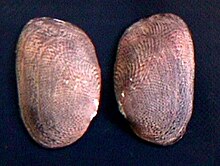| Hyriidae | |
|---|---|

| |
| External view of two valves of Diplodon granosus | |
| Scientific classification | |
| Domain: | Eukaryota |
| Kingdom: | Animalia |
| Phylum: | Mollusca |
| Class: | Bivalvia |
| Order: | Unionida |
| Superfamily: | Hyrioidea Swainson, 1840 |
| Family: | Hyriidae Swainson, 1840 |
| Genera | |
|
See text | |
Hyriidae is a taxonomic family of pearly freshwater mussels, aquatic bivalve molluscs in the order Unionida. This family is native to South America, Australia, New Zealand and New Guinea.[1] Like all members of that order, they go through a larval stage that is parasitic on fish (see glochidium).
The classification recognized by Banarescu (1995)[2] uses three subfamilies. This family contains eighteen genera.
Subfamilies and genera
[edit]Hyriinae
[edit]Genera within the subfamily Hyriinae, from South America, include:
- Tribe Castaliini
- Tribe Hyriini
- Tribe Rhipidodontini
Cucumerunioninae
[edit]Genera within the subfamily Cucumerunioninae, from Australasia, include:
Velesunioninae
[edit]Genera within the subfamily Velesunioninae, from Australasia, include:[citation needed]
- Alathyria
- Alathyria jacksoni, the river mussel (or black river mussel[3]) occurs in South Australia.[4]
- Haasodonta
- Lortiella
- Microdonta
- Velesunio
- Westralunio
References
[edit]- ^ Huber, Markus (2010). Compendium of Bivalves. A Full-color Guide to 3'300 of the World's Marine Bivalves. A Status on Bivalvia after 250 Years of Research. Hackenheim: ConchBooks. pp. 901 pp. + CD. ISBN 978-3-939767-28-2.
- ^ Banarescu, Petru (1995). Zoogeography of Fresh Waters. Volume 3: Distribution and dispersal of freshwater animals in Africa, Pacific Areas and South America. Wiesbaden: AULA-Verlag. ISBN 978-3-89104-483-4.
- ^ "Yerta Bulti (Port River and Estuary region)". City of Charles Sturt. 26 August 2019. Retrieved 24 November 2020.
- ^ Wade, Sam; Corbin, Tracey; McDowell, Linda-Marie (June 2004). Critter Catalogue: A guide to the aquatic invertebrates of South Australian inland waters (PDF). Original illustrations by John Bradbury. Environment Protection Authority (South Australia). p. 28. ISBN 1-876562-67-6.
Well, that’s interesting to know that Psilotum nudum are known as whisk ferns. Psilotum nudum is the commoner species of the two. While the P. flaccidum is a rare species and is found in the tropical islands. Both the species are usually epiphytic in habit and grow upon tree ferns. These species may also be terrestrial and grow in humus or in the crevices of the rocks.
View the detailed Guide of Psilotum nudum: Detailed Study Of Psilotum Nudum (Whisk Fern), Classification, Anatomy, Reproduction